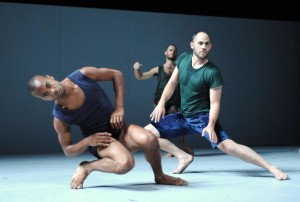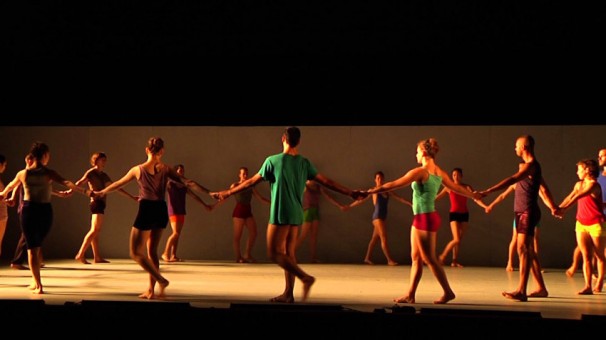Days after watching Batsheva Dance Company bring choreographer Ohad Naharin’s splendid full-evening work, “Sadeh21,” to vivid life in its U.S. premiere at the Center for the Art of Performance at UCLA, I am struck by the inadequacy of still photography in capturing the dance’s essence.
The benign ring-around-the-rosy image, above, does not represent the multi-chaptered dance, which is often tinged with high tension.
 The camera click on the ring of dancers followed a long build-up. One by one, performers filtered onstage and linked hands in an ever-expansive circle. Is that brilliant choreography? Hell no, grade-school kids do it daily in the playground. But what I remember is how slooooow the tempo: slow as a heartbeat, lub-dub, eating gobs of time, as it rolled out. It allowed the viewer to not just gaze but (visually) graze . You didn’t just watch it, you lived it.
The camera click on the ring of dancers followed a long build-up. One by one, performers filtered onstage and linked hands in an ever-expansive circle. Is that brilliant choreography? Hell no, grade-school kids do it daily in the playground. But what I remember is how slooooow the tempo: slow as a heartbeat, lub-dub, eating gobs of time, as it rolled out. It allowed the viewer to not just gaze but (visually) graze . You didn’t just watch it, you lived it.
The rigor of tempi drove great swathes of “Sadeh,” as a compositional element. (Sustaining slowness, I would posit, a choreographer’s acid test.) As viewing, this pagaent proved an antidote to our relentless times — not to mention a “so there” retort to dance’s hyper-kineticness of recent decades.
Nor does the provocative headstand by dancer Bobbi Smith, pictured above, encapsulate the work. And yet there she is, an upside-down tulip, succulent-red, posing and squirming in redolent sexuality. Then she’s Diana Ross fronting fellow Batsheva ladies in a deconstructed Supremes back-up dance overlaid with contemporary attitude. At another point, three girls knot their hands into fists as music crescendos; that would be anger. Another female moment has a solo dancer, garbed in green, stepping-crazy, her hips tick-tocking in a queer rocking motion over and over.
 Neither does the edgy masculine energy in the photo at left “summarize” Sadeh21. But at one point, seven men occupy downstage — a chorus line — each raising one leg, foot flexed; it hearkens a frozen folk dance. The music is schmaltzy, the posers deadpanned.
Neither does the edgy masculine energy in the photo at left “summarize” Sadeh21. But at one point, seven men occupy downstage — a chorus line — each raising one leg, foot flexed; it hearkens a frozen folk dance. The music is schmaltzy, the posers deadpanned.
There’s no easy reduction of this work, which doesn’t mean it does not cling together; it does, and seamlessly. It fully functions as a whole piece comprised of oh-so-many disparate, rich and discrete dance chapters and moments.
Naharin, who now must be viewed as one of our great global dance-maestros, builds tableaux in “Sadeh” best likened to Brueghel paintings. There they are, a morass of dancers milling about in haphazard humanity. A picture of “us.” And here we sit, in the audience, watching them. (That’s the photo of “Sadeh” … a face-off between performer and audience.) A dance company, if nothing else, is mini-morass, a small cult, a closed society. In Batsheva’s case, state funding allows for a glorious 18 members whom Naharin puts to marvelous use. First they get solos, then they hang in the group. A high point arrives when they form a long diagonal queue, some facing front, some back, some paired and gazing at each other. They barely move; “dancing” is minimal; it’s gestural and pedestrian but gripping as it melds with the ambient music (score by Naharin).
Naharin mentioned in a post-performance conversation that he’d like to do an entire evening of this “nothing” dancing.
Hey, if presented amidst gorgeous lighting, a cool score dotted with clashing sound bursts, exposed lights, half-board walls, just like “Sadeh21,” well, I’ll be there.
Like this? Read more:

